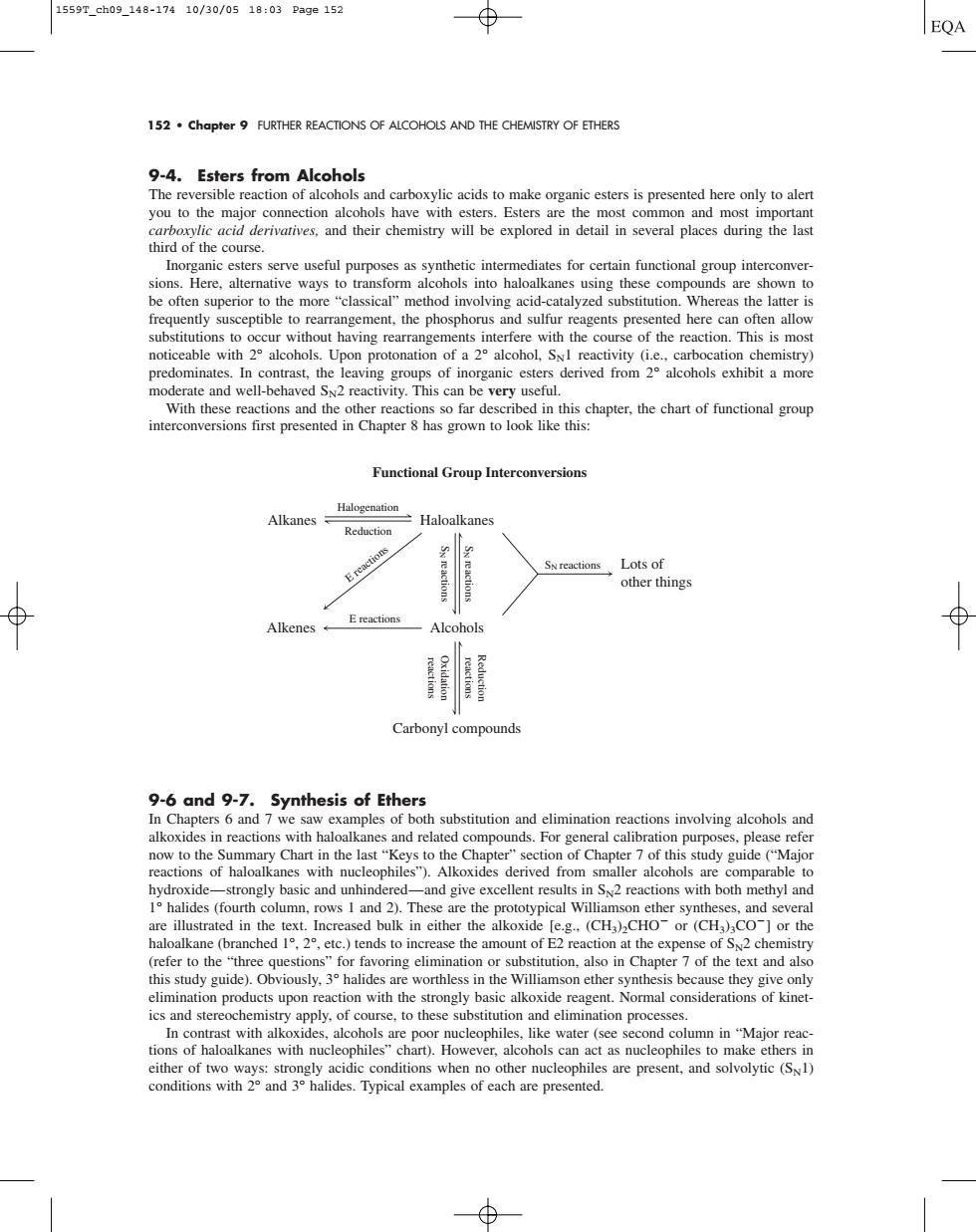正在加载图片...

1559r.ah09.148-17410/30/0518:03Page152 EQA 152.chapter9 FURTHER REACTIONS OF ALCOHOLS AND THE CHEMISTRY OF ETHERS 9-4.Esters from Alcohols The re their chemistry will be explored in detail in several places during the last third of the course. be often superior to the more"assical"method involving acid-catalyzed substitution.Whereas the latter is rast. With these reactions and the other reactions so far de interconversions first presented in Chapter 8 has grown to look like this: Functional Group Interconversions Reduction Haloalkanes Ss reactions Lots of other things Alkenes Alcohols Carbonyl compounds 9-6 and 9-7. Synthesis of Ethe strongly basic and unhindered-and give excellent results in S2 reactions with both methyl and I°halides(fourth olumn,rows I and 2).Thes are the prototypical Willia nson ether syntheses, g(CH at th or(CH (refer to the this study guid Obviously.3 halides are worthl ics and stereochemistr plyocoetotheesbsiionandehonceg ske water (sce s column in"Majo r reac conditions with 2 and 3 halides.Typical examples of cach are presented152 • Chapter 9 FURTHER REACTIONS OF ALCOHOLS AND THE CHEMISTRY OF ETHERS 9-4. Esters from Alcohols The reversible reaction of alcohols and carboxylic acids to make organic esters is presented here only to alert you to the major connection alcohols have with esters. Esters are the most common and most important carboxylic acid derivatives, and their chemistry will be explored in detail in several places during the last third of the course. Inorganic esters serve useful purposes as synthetic intermediates for certain functional group interconversions. Here, alternative ways to transform alcohols into haloalkanes using these compounds are shown to be often superior to the more “classical” method involving acid-catalyzed substitution. Whereas the latter is frequently susceptible to rearrangement, the phosphorus and sulfur reagents presented here can often allow substitutions to occur without having rearrangements interfere with the course of the reaction. This is most noticeable with 2° alcohols. Upon protonation of a 2° alcohol, SN1 reactivity (i.e., carbocation chemistry) predominates. In contrast, the leaving groups of inorganic esters derived from 2° alcohols exhibit a more moderate and well-behaved SN2 reactivity. This can be very useful. With these reactions and the other reactions so far described in this chapter, the chart of functional group interconversions first presented in Chapter 8 has grown to look like this: 9-6 and 9-7. Synthesis of Ethers In Chapters 6 and 7 we saw examples of both substitution and elimination reactions involving alcohols and alkoxides in reactions with haloalkanes and related compounds. For general calibration purposes, please refer now to the Summary Chart in the last “Keys to the Chapter” section of Chapter 7 of this study guide (“Major reactions of haloalkanes with nucleophiles”). Alkoxides derived from smaller alcohols are comparable to hydroxide—strongly basic and unhindered—and give excellent results in SN2 reactions with both methyl and 1° halides (fourth column, rows 1 and 2). These are the prototypical Williamson ether syntheses, and several are illustrated in the text. Increased bulk in either the alkoxide [e.g., (CH3)2CHO or (CH3)3CO] or the haloalkane (branched 1°, 2°, etc.) tends to increase the amount of E2 reaction at the expense of SN2 chemistry (refer to the “three questions” for favoring elimination or substitution, also in Chapter 7 of the text and also this study guide). Obviously, 3° halides are worthless in the Williamson ether synthesis because they give only elimination products upon reaction with the strongly basic alkoxide reagent. Normal considerations of kinetics and stereochemistry apply, of course, to these substitution and elimination processes. In contrast with alkoxides, alcohols are poor nucleophiles, like water (see second column in “Major reactions of haloalkanes with nucleophiles” chart). However, alcohols can act as nucleophiles to make ethers in either of two ways: strongly acidic conditions when no other nucleophiles are present, and solvolytic (SN1) conditions with 2° and 3° halides. Typical examples of each are presented. Alkanes Haloalkanes Alkenes Alcohols Carbonyl compounds Lots of other things Functional Group Interconversions Halogenation Reduction E reactions E reactions SN reactions SN reactions SN reactions Reduction reactions Oxidation reactions 1559T_ch09_148-174 10/30/05 18:03 Page 152